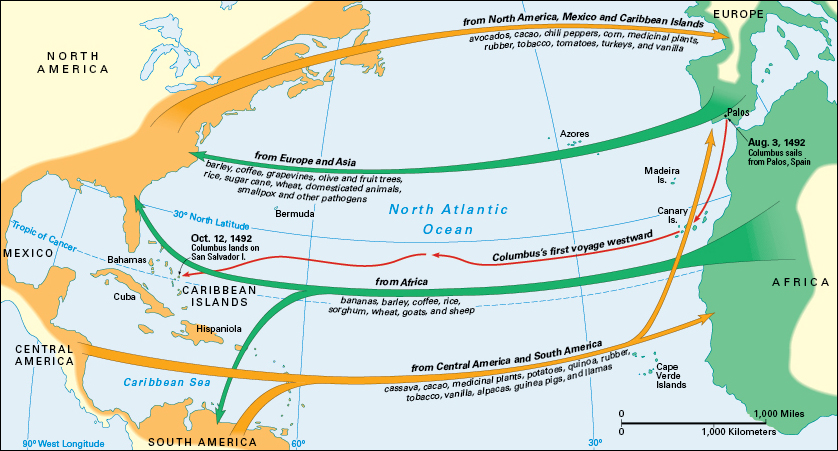Columbian Exchange is the term used to describe the exchange of plants, animals, and diseases between Afro-Eurasia (Africa, Europe, and Asia) and the Americas. The exchange was set in motion in 1492. That year, the Italian navigator Christopher Columbus sailed west from Europe, across the Atlantic Ocean, to the Caribbean region. His journey began a period of European exploration of North and South America. The American historian Alfred Crosby introduced the term Columbian Exchange, as well as the concept of the exchange, in the early 1970’s.

Separate worlds.
Before 1492, the peoples of Afro-Eurasia did not know that two American continents existed. Columbus himself never knew, or at least never admitted, that he had come upon a “New World.” But his voyages triggered the establishment of regular transatlantic trade routes linking the Eastern and Western hemispheres. Until Columbus’s voyages, the Americas had developed in almost total isolation from Afro-Eurasia. Different kinds of animals, diseases, and foods developed in each place.
In Afro-Eurasia, people cultivated mainly barley, rice, sorghum, and wheat. They raised such animals as chickens, cows, goats, horses, pigs, and sheep. The animals provided clothing, food, labor, shelter, and transportation. Afro-Eurasian peoples were exposed to a variety of diseases, which traveled among people and domestic (tame) animals.
The main crops cultivated by farming societies in North America—particularly in Mexico and Central America (sometimes called Mesoamerica)—were beans, maize (corn), and squash. The main crops grown by South American peoples were cassava, corn, potatoes, and quinoa. The Americas had few kinds of domestic animals. People raised a few kinds of animals for food. These included guinea pigs in the Andes Mountains and turkeys in Mesoamerica and what is now the southwestern United States. In the Andes, people also used alpacas and llamas for transportation and wool. Domestic dogs were widespread throughout the Americas.
Indigenous (native) Americans also encountered a variety of diseases. However, they were isolated from diseases common to Afro-Eurasia, such as bubonic plague, influenza, measles, and smallpox.
Impact on the Americas.
Europeans who traveled to the Americas began exchanging goods with the people there. Early European travelers carried olive and other fruit trees, grapevines, and wheat to the Western Hemisphere. Over time, a number of cash crops transported from Afro-Eurasia became bases of plantation agriculture throughout the Americas. These crops included bananas, coffee, rice, and sugar cane. Plantations were worked mainly by slaves, and an increasing demand for labor caused the slave trade to grow.
Early European travelers also transported domestic animals to the Americas. Cows, horses, pigs, and sheep thrived in the new environment. They had plenty to eat and almost no natural predators. The rapidly multiplying animals soon had an impact on the environment. Heavy grazing and the animals’ hard hoofs exposed and damaged the topsoil. Rain then washed away even more exposed soil. As a result, native plants no longer could grow in many areas. Some of these areas became desertlike. Many areas were taken over by clovers and grasses that had been carried from Afro-Eurasia.
The introduction of animals from Afro-Eurasia altered indigenous American societies by providing new sources of food and transportation. It also stimulated new economic ventures. Herds of cows became the basis for a cattle-ranching industry that exported beef, tallow (animal fat), and hides. Sheepherding also developed, producing wool and mutton. Mules were used to transport goods across mountainous regions of Mexico.
Perhaps the most devastating result of the Columbian Exchange was the introduction of unfamiliar pathogens (disease-causing substances) to the Americas. American peoples never had developed immunity (resistance) to such pathogens. Thus, diseases that had become commonplace in Afro-Eurasia, especially smallpox, were extremely dangerous to indigenous Americans. Some historians estimate that the indigenous American population fell by more than 90 percent by the early 1600’s.
Impact on Afro-Eurasia.
The Columbian Exchange also involved the transport of American products to Afro-Eurasia. The spread of native American crops has had an enormous impact on the global population. Such cash crops as cacao, rubber trees, vanilla, and tobacco spurred further development of plantation agriculture and of global trade. Medicines came from some plants, such as the cinchona tree, used in drugs to treat malaria. Some food crops, especially corn and potatoes, were highly nutritious and grew well in many regions. Several other food plants new to the rest of the world included avocados, cassava, chili peppers, and tomatoes. The spread of American crops greatly increased the amount of food available to the world’s population and has led to great population growth.
